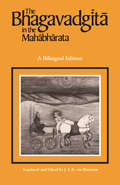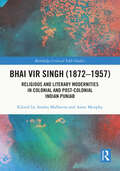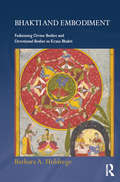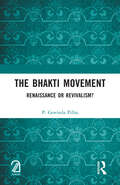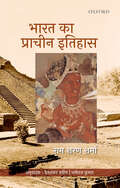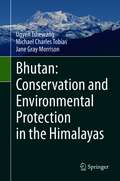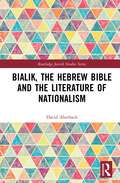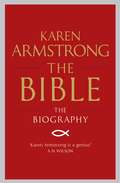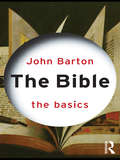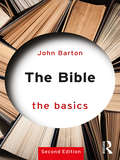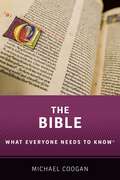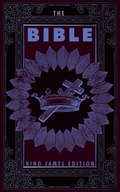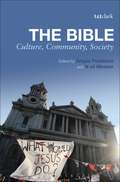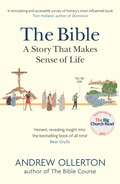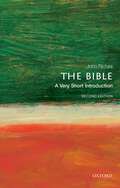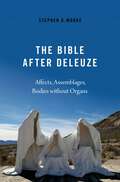- Table View
- List View
The Bhagavadgita in the Mahabharata
by J. A. B. van BuitenenNo other Sanskrit work approaches the Bhagavadgita in the influence it has exerted in the West. Philosophers such as Emerson and the other New England Transcendentalists were deeply affected by its insights, a dozen or more scholars, including Annie Besant and Mahatma Gandhi, have attempted its translation, and thousands of individuals struggling with the problems divided loyalties have found comfort and wisdom in its pages. The Bhagavadgita ("Song of the Lord") tells of the young and virtuous Prince Arjuna who is driven to lead his forces into battle against an opposing army composed of close relatives and others whom he loves. The Lord Krsna, appearing in the poem as Arjuna's friend and charioteer, persuades him that he must do battle, and we see Arjuna changing from revulsion at the thought of killing members of his family to resignation and awareness of duty, to manly acceptance of his role as warrior and defender of his kingdom. The Bhagavadgita is a self-contained episode in the Mahabharata, a vast collection of epics, legends, romances, theology, and metaphysical doctrine that reflects the history and culture of the whole of Hindu civilization. The present edition forms a part of J. A. B. van Buitenen's widely acclaimed translation of this great work. Here English and Sanskrit are printed on facing pages, enabling those with some knowledge of Sanskrit to appreciate van Buitenen's accurate rendering of the intimate, familial tone and directness of the original poem.
The Bhagavadgita in the Mahabharata
by J. A. B. van BuitenenNo other Sanskrit work approaches the Bhagavadgita in the influence it has exerted in the West. Philosophers such as Emerson and the other New England Transcendentalists were deeply affected by its insights, a dozen or more scholars, including Annie Besant and Mahatma Gandhi, have attempted its translation, and thousands of individuals struggling with the problems divided loyalties have found comfort and wisdom in its pages. The Bhagavadgita ("Song of the Lord") tells of the young and virtuous Prince Arjuna who is driven to lead his forces into battle against an opposing army composed of close relatives and others whom he loves. The Lord Krsna, appearing in the poem as Arjuna's friend and charioteer, persuades him that he must do battle, and we see Arjuna changing from revulsion at the thought of killing members of his family to resignation and awareness of duty, to manly acceptance of his role as warrior and defender of his kingdom. The Bhagavadgita is a self-contained episode in the Mahabharata, a vast collection of epics, legends, romances, theology, and metaphysical doctrine that reflects the history and culture of the whole of Hindu civilization. The present edition forms a part of J. A. B. van Buitenen's widely acclaimed translation of this great work. Here English and Sanskrit are printed on facing pages, enabling those with some knowledge of Sanskrit to appreciate van Buitenen's accurate rendering of the intimate, familial tone and directness of the original poem.
Bhai Vir Singh: Religious and Literary Modernities in Colonial and Post-Colonial Indian Punjab (Routledge Critical Sikh Studies)
by Anshu Malhotra Anne MurphyThis volume brings together works by established and emerging scholars to consider the work and impact of Bhai Vir Singh. Bhai Vir Singh (1872-1957) was a major force in the shaping of modern Sikh and Punjabi culture, language, and politics in the undivided colonial Punjab, prior to the Partition of the province in 1947, and in the post-colonial state of India. The chapters in this book explore how he both reflected and shaped his time and context and address some of the ongoing legacy of his work in the lives of contemporary Sikhs. The contributors analyze the varied genres, literary, and historical that were adopted and adapted by Bhai Vir Singh to foreground and enhance Sikh religiosity and identity. These include his novels, didactic pamphlets, journalistic writing, prefatory and exegetical work on spiritual and secular historical documents, and his poems and lyrics, among others. This book will be of particular interest to those working in Sikh studies, South Asian studies, and post-colonial studies.
Bhai Vir Singh: Religious and Literary Modernities in Colonial and Post-Colonial Indian Punjab (Routledge Critical Sikh Studies)
This volume brings together works by established and emerging scholars to consider the work and impact of Bhai Vir Singh. Bhai Vir Singh (1872-1957) was a major force in the shaping of modern Sikh and Punjabi culture, language, and politics in the undivided colonial Punjab, prior to the Partition of the province in 1947, and in the post-colonial state of India. The chapters in this book explore how he both reflected and shaped his time and context and address some of the ongoing legacy of his work in the lives of contemporary Sikhs. The contributors analyze the varied genres, literary, and historical that were adopted and adapted by Bhai Vir Singh to foreground and enhance Sikh religiosity and identity. These include his novels, didactic pamphlets, journalistic writing, prefatory and exegetical work on spiritual and secular historical documents, and his poems and lyrics, among others. This book will be of particular interest to those working in Sikh studies, South Asian studies, and post-colonial studies.
Bhakti and Embodiment: Fashioning Divine Bodies and Devotional Bodies in Krsna Bhakti (Routledge Hindu Studies Series)
by Barbara A. HoldregeThe historical shift from Vedic traditions to post-Vedic bhakti (devotional) traditions is accompanied by a shift from abstract, translocal notions of divinity to particularized, localized notions of divinity and a corresponding shift from aniconic to iconic traditions and from temporary sacrificial arenas to established temple sites. In Bhakti and Embodiment Barbara Holdrege argues that the various transformations that characterize this historical shift are a direct consequence of newly emerging discourses of the body in bhakti traditions in which constructions of divine embodiment proliferate, celebrating the notion that a deity, while remaining translocal, can appear in manifold corporeal forms in different times and different localities on different planes of existence. Holdrege suggests that an exploration of the connections between bhakti and embodiment is critical not only to illuminating the distinctive transformations that characterize the emergence of bhakti traditions but also to understanding the myriad forms that bhakti has historically assumed up to the present time. This study is concerned more specifically with the multileveled models of embodiment and systems of bodily practices through which divine bodies and devotional bodies are fashioned in Krsna bhakti traditions and focuses in particular on two case studies: the Bhagavata Purana, the consummate textual monument to Vaisnava bhakti, which expresses a distinctive form of passionate and ecstatic bhakti that is distinguished by its embodied nature; and the Gaudiya Vaisnava tradition, an important bhakti tradition inspired by the Bengali leader Caitanya in the sixteenth century, which articulates a robust discourse of embodiment pertaining to the divine bodies of Krsna and the devotional bodies of Krsna bhaktas that is grounded in the canonical authority of the Bhagavata Purana.
Bhakti and Embodiment: Fashioning Divine Bodies and Devotional Bodies in Krsna Bhakti (Routledge Hindu Studies Series)
by Barbara A. HoldregeThe historical shift from Vedic traditions to post-Vedic bhakti (devotional) traditions is accompanied by a shift from abstract, translocal notions of divinity to particularized, localized notions of divinity and a corresponding shift from aniconic to iconic traditions and from temporary sacrificial arenas to established temple sites. In Bhakti and Embodiment Barbara Holdrege argues that the various transformations that characterize this historical shift are a direct consequence of newly emerging discourses of the body in bhakti traditions in which constructions of divine embodiment proliferate, celebrating the notion that a deity, while remaining translocal, can appear in manifold corporeal forms in different times and different localities on different planes of existence. Holdrege suggests that an exploration of the connections between bhakti and embodiment is critical not only to illuminating the distinctive transformations that characterize the emergence of bhakti traditions but also to understanding the myriad forms that bhakti has historically assumed up to the present time. This study is concerned more specifically with the multileveled models of embodiment and systems of bodily practices through which divine bodies and devotional bodies are fashioned in Krsna bhakti traditions and focuses in particular on two case studies: the Bhagavata Purana, the consummate textual monument to Vaisnava bhakti, which expresses a distinctive form of passionate and ecstatic bhakti that is distinguished by its embodied nature; and the Gaudiya Vaisnava tradition, an important bhakti tradition inspired by the Bengali leader Caitanya in the sixteenth century, which articulates a robust discourse of embodiment pertaining to the divine bodies of Krsna and the devotional bodies of Krsna bhaktas that is grounded in the canonical authority of the Bhagavata Purana.
The Bhakti Movement: Renaissance or Revivalism?
by P. Govinda PillaiThis is a Comprehensive Survey of the Bhakti Movement as it sprang in South India to spread across the subcontinent in independent and multifarious manifestations yet marked with amazing commonalities. Spanning a period of 11 centuries starting from the 6th CE, the movement encompassed in its sweep a vast range of dimensions; Social, political, economic, religious, cultural, linguistic, ethical and philosophical. Among the multifarious movements which contributed to the formation of India and its Culture, the Bhakti was undoubtedly the most pervasive and persistent, says the author. Besides its sweep and depth, what proved most remarkable about the movement was that it arose almost everywhere from the masses who belonged to the lowest class and castes. Though spirituality was its leitmotif, Bhakti proved to be a stirring song of the subaltern in their varied expressions of resistance and revolt. A seemingly conservative phenomenon became a potent weapon against entrenched hierarchies of orthodoxy and oppression, in a wonderful dialectical expression. This qualifies Bhakti movement to be reckoned on a par with European renaissance as it marked a massive upsurge in the societal value system to directly impact a range of fields like arts, politics, culture or religion. Even as he takes note of the elements of reactionary revivalism that also marked the Bhakti movement, the author convincingly argues that those of renaissance and progress far outweighed the former.
The Bhakti Movement: Renaissance or Revivalism?
by P. Govinda PillaiThis is a Comprehensive Survey of the Bhakti Movement as it sprang in South India to spread across the subcontinent in independent and multifarious manifestations yet marked with amazing commonalities. Spanning a period of 11 centuries starting from the 6th CE, the movement encompassed in its sweep a vast range of dimensions; Social, political, economic, religious, cultural, linguistic, ethical and philosophical. Among the multifarious movements which contributed to the formation of India and its Culture, the Bhakti was undoubtedly the most pervasive and persistent, says the author. Besides its sweep and depth, what proved most remarkable about the movement was that it arose almost everywhere from the masses who belonged to the lowest class and castes. Though spirituality was its leitmotif, Bhakti proved to be a stirring song of the subaltern in their varied expressions of resistance and revolt. A seemingly conservative phenomenon became a potent weapon against entrenched hierarchies of orthodoxy and oppression, in a wonderful dialectical expression. This qualifies Bhakti movement to be reckoned on a par with European renaissance as it marked a massive upsurge in the societal value system to directly impact a range of fields like arts, politics, culture or religion. Even as he takes note of the elements of reactionary revivalism that also marked the Bhakti movement, the author convincingly argues that those of renaissance and progress far outweighed the former.
Bharat ka Prachin Itihas
by Ram Sharan SharmaBeginning with a discussion on frameworks of writing history, the volume sheds light on the origins and growth of civilizations, empires, and religions. It covers the geographical, ecological, and linguistic backgrounds, and looks at specific cultures of the Neolithic, Chalcolithic, and Vedic periods, as well as the Harappan civilization. The author discussed the rise of Jainism and Buddhism, Magadha, and the beginning of territorial states. The period of Mauryas, Central Asian countries, Satavahanas, Guptas, and Harshvardhana are also analysed. He highlights important phenomena such as the varna system, urbanization, commerce and trade, developments in science and philosophy, and cultural legacy. He also examines the process of transition from ancient to medieval India and addresses topical issues such as the origin of the Aryan culture. This engaging and lucid text, by one of the best-known scholars of ancient India, will be indispensable for students and teachers of ancient Indian history. This book is the Hindi translation of the English edition.
Bhutan: Conservation and Environmental Protection in the Himalayas
by Ugyen Tshewang Michael Charles Tobias Jane Gray MorrisonLocated in the heart of the Eastern Himalayas, Bhutan practices the philosophy of Gross National Happiness (“GNH”) that embraces environmental conservation as one of the main building blocks for its sustainable development goals. Bhutan’s conservation strategies and success are largely driven by the strong political will and visionary leadership of His Majesty the King of Bhutan The nation’s Buddhist perspectives regarding a deep and abiding respect for nature; and the strategic enforcement of a wide-ranging stringent set of internal regulations and controls have helped ensure ecological gold standards in Bhutan. Moreover, the country is an active member of the international conservation community by fulfilling its implementation of various Multilateral Environment Agreements. While it emerged into the 21st century as one of the 36 global terrestrial “hotspots” in biological diversity conservation ranks, Bhutan’s sheer commitment with more than 51% of its territory being managed under the explicit status of a protected area network, and more than 70% of the land under forest cover, represents Bhutan’s exemplary dedication to protect the planet despite its smallness in size and economy, and the biological fragility exemplified by its hotspot situation. In the face of imminent severe threats of global warming, Bhutan nonetheless exemplifies the truth that “a small country with a big conservation commitment” can make an enormous contribution to the global community.At the regional level, Bhutan is intent upon protecting the Water Towers of Asia (that glacial expanse of the Himalayas) which is a critical resource bulwark for about one-fifth of the global population downstream in South Asia. Such protections invariably help mitigate climate change by acting as a nation-wide carbon sink through its carbon neutral policies. In short, Bhutan has long represented one of the world’s foremost national guardians of biodiversity conservation, ecological good governance, and societal sustainability at a period when the world has entered the Anthropocene – an epoch of mass extinctions.We envision this publication to be ecologically and ethically provocative and revealing for the concerned scientific communities, and governments. Through an extensive review of the scientific and anthropological literature, as well as the research team's own data, the Author's have set forth timely recommendations for conservation policies, strategies and actions. This book provides technical and deeply considered assessments of the state of Bhutan’s environment, its multiple, human-induced stressors and pressures; as well as extremely sound, practical techniques that would address conservation strategies in the Himalayas and, by implication, worldwide.
Bialik, the Hebrew Bible and the Literature of Nationalism (Routledge Jewish Studies Series)
by David AberbachThis book explores the life and poetry of Chaim Nachman Bialik (1873–1934) in the context of European national literature between the French Revolution and World War I, showing how he helped create a modern Hebrew national culture, spurring the revival of Hebrew as a spoken language. The author begins with Bialik’s background in the Tsarist Empire, contextualizing Jewish powerlessness in Eastern Europe in the late nineteenth century. As European anti-Semitism grew, Bialik emerged at the vanguard of a modern Hebrew national movement, building on ancient biblical and rabbinic tradition and speaking to Jewish concerns in neo-prophetic poems, love poems, poems for children, and folk poems. This book makes accessible a broad but representative selection of Bialik’s poetry in translation. Alongside this, a variety of national poets are considered from across Europe, including Solomos in Greece, Mickiewicz in Poland, Shevchenko in Ukraine, Njegoš in Serbia, Petőfi in Hungary, and Yeats in Ireland. Aberbach argues that Bialik as Jewish national poet cannot be understood except in the dual context of ancient Jewish nationalism and modern European nationalism, both political and cultural. Written in clear and accessible prose, this book will interest those studying modern European nationalism, Hebrew literature, Jewish history, and anti-Semitism.
Bialik, the Hebrew Bible and the Literature of Nationalism (Routledge Jewish Studies Series)
by David AberbachThis book explores the life and poetry of Chaim Nachman Bialik (1873–1934) in the context of European national literature between the French Revolution and World War I, showing how he helped create a modern Hebrew national culture, spurring the revival of Hebrew as a spoken language. The author begins with Bialik’s background in the Tsarist Empire, contextualizing Jewish powerlessness in Eastern Europe in the late nineteenth century. As European anti-Semitism grew, Bialik emerged at the vanguard of a modern Hebrew national movement, building on ancient biblical and rabbinic tradition and speaking to Jewish concerns in neo-prophetic poems, love poems, poems for children, and folk poems. This book makes accessible a broad but representative selection of Bialik’s poetry in translation. Alongside this, a variety of national poets are considered from across Europe, including Solomos in Greece, Mickiewicz in Poland, Shevchenko in Ukraine, Njegoš in Serbia, Petőfi in Hungary, and Yeats in Ireland. Aberbach argues that Bialik as Jewish national poet cannot be understood except in the dual context of ancient Jewish nationalism and modern European nationalism, both political and cultural. Written in clear and accessible prose, this book will interest those studying modern European nationalism, Hebrew literature, Jewish history, and anti-Semitism.
The Bible: The Biography (BOOKS THAT SHOOK THE WORLD #8)
by Karen ArmstrongThe Bible is the most widely distributed book in the world. Translated into over two thousand languages, it is estimated that more than six billion copies have been sold in the last two hundred years alone. In this seminal account, Karen Armstrong traces the gestation of the Bible to reveal a complex and contradictory document created by scores of people over hundreds of years. Karen Armstrong begins her analysis with the origins of the very earliest books of the Hebrew Bible, in which God was called both 'Yahweh' and 'Elohim'. She then traces the development of both the Hebrew Bible and the New Testament to reveal the disparate influences that helped to form these sacred texts. From the Jewish practice of Midrash and the Christian cult of Jesus; to the influence of Paul's letters on the Reformation and the manipulation of Revelations by Christian fundamentalism, Armstrong explores the contexts in which these sixty-six books were understood and explains the social needs they answered. In the process she reveals an unfamiliar and paradoxical work that will permanently alter our understanding of the Bible.
The Bible: The Basics (The Basics)
by John BartonThe Bible: The Basics is a compelling introduction to the Bible as both a sacred text, central to the faith of millions, and a classic work of Western literature, containing a tapestry of genres, voices, perspectives and images. This masterly guide skilfully addresses both aspects of the Bible’s character by exploring: the rich variety of literary forms, from poetry to prophecy and epistles to apocalypses the historical, geographic and social context of the Bible contemporary attitudes to the Bible held by believers and non-believers the status of biblical interpretation today Including maps, a chronology and detailed suggestions for further reading, this is an ideal starting point for people of any faith or none who are studying the Bible in any setting or simply want to know more about the best-selling book of all time.
The Bible: The Basics (The Basics)
by John BartonThe Bible: The Basics is a compelling introduction to the Bible as both a sacred text, central to the faith of millions, and a classic work of Western literature, containing a tapestry of genres, voices, perspectives and images. This masterly guide skilfully addresses both aspects of the Bible’s character by exploring: the rich variety of literary forms, from poetry to prophecy and epistles to apocalypses the historical, geographic and social context of the Bible contemporary attitudes to the Bible held by believers and non-believers the status of biblical interpretation today Including maps, a chronology and detailed suggestions for further reading, this is an ideal starting point for people of any faith or none who are studying the Bible in any setting or simply want to know more about the best-selling book of all time.
The Bible: The Basics (The\basics Ser. (PDF))
by John BartonThe Bible: The Basics is an accessible and engaging introduction to the Bible as both a sacred text, central to the faith of millions, and a classic work of Western literature, containing a tapestry of genres, voices, perspectives and images. This guide skilfully addresses both aspects of the Bible’s character by exploring: the rich variety of literary forms, from poetry to prophecy and epistles to apocalypses the historical, geographic and social context of the Bible contemporary attitudes to the Bible held by believers and non-believers the status of biblical interpretation today The second edition has been updated throughout and includes: maps and detailed suggestions for further reading. This is an ideal starting point for people of any faith or none who are studying the Bible in any setting or simply want to know more about the best-selling book of all time.
The Bible: The Basics (The Basics)
by John BartonThe Bible: The Basics is an accessible and engaging introduction to the Bible as both a sacred text, central to the faith of millions, and a classic work of Western literature, containing a tapestry of genres, voices, perspectives, and images. This guide skilfully addresses both aspects of the Bible’s character by exploring: the rich variety of literary forms, from poetry to prophecy and epistles to apocalypses; the historical, geographic, and social context of the Bible; contemporary attitudes to the Bible held by believers and non-believers; the status of biblical interpretation today. The second edition has been updated throughout and includes maps and detailed suggestions for further reading. This is an ideal starting point for people of any faith, or none, who are studying the Bible in any setting or who simply want to know more about the best-selling book of all time.
The Bible: What Everyone Needs to Know® (What Everyone Needs to Know)
by Michael CooganThe Bible is the most influential book in Western history. As the foundational text of Judaism and Christianity, the Bible has been interpreted and reinterpreted over millennia, utilized to promote a seemingly endless run of theological and political positions. Adherents and detractors alike point to different passages throughout to justify wildly disparate behaviors and beliefs. Translated and retranslated, these texts lead both to unity and intense conflict. Influential books on any topic are typically called "bibles." What is the Bible? As a text considered sacred by some, its stories and language appear throughout the fine arts and popular culture, from Shakespeare to Saturday Night Live. In Michael Coogan's eagerly awaited addition to Oxford's What Everyone Needs to Know® series, conflicts and controversies surrounding the world's bestselling book are addressed in a straightforward Q&A format. This book provides an unbiased look at biblical authority and authorship, the Bible's influence in Western culture, the disputes over meaning and interpretation, and the state of biblical scholarship today. Brimming with information for the student and the expert alike, The Bible: What Everyone Needs to Know ® is a dependable introduction to a most contentious holy book.
The Bible
by Random HouseOriginally produced for the Church of England, The King James Version is one of the most enduring translations of The Bible. It's combination of poeticism and readability have made it the most prominent version of the best-selling book in human history. Penguin Random House Canada is proud to bring you classic works of literature in e-book form, with the highest quality production values. Find more today and rediscover books you never knew you loved.
The Bible: Culture, Community, Society
by Angus Paddison Neil MesserWhat kind of authority does Scripture have? How is Scripture's authority to be negotiated in relation to other sources of authority? And what are the implications of confessing the Bible to be authoritative? The Bible: Culture, Community and Society seeks to answer these questions, covering three core themes. First, reading the Bible in the context of modernity - the challenges the intellectual history of modernity has posed to the Bible's authority and how historical work can co-exist with a commitment to the Bible as the Word of God. Secondly, the Bible as a text that forms the church community - how the Bible as an authoritative text shapes a culture. Thirdly, reading the Bible as a public text and the challenges posed by holding to the Bible as the Word of God in a religiously diverse context. The highly distinguished contributors include Ben Quash, David Ferguson, Angus Paddison and Zoë Bennett.
The Bible: A Story that Makes Sense of Life
by Andrew Ollerton'Honest, revealing insight into the bestselling book of all time.'Bear Grylls'A stimulating and accessible survey of history's most influential book.'Tom Holland, historian and author of Dominion'Personal and profound; informative and practical. If you want to experience the Bible as a rich source of guidance and hope, this book is for you.'Simon Thomas, former Sky Sports and Blue Peter presenterWhen we make sense of the Bible, the Bible makes sense of us.The political, social and cultural upheaval of our times can leave us feeling bewildered and wondering where to turn for trustworthy guidance. As unlikely as it may seem, could the Bible provide ancient wisdom that helps us flourish today? Join Andrew Ollerton as he explores the storyline of Scripture, connecting six major biblical events with six definitive human needs: for meaning, freedom, peace, community, love and for an ultimate home. In short, digestible chapters, Andrew reveals how the Bible story makes sense of our human story.Discover for yourself a limitless source of guidance and hope in the face of so much uncertainty.Underpinned by a depth of scholarship, the book is non-technical in style, making it accessible for the widest possible readership - including Christians and seekers interested in the Bible. The book will also provide a model for Bible communicators and church leaders wishing to engage more deeply with the relevance of the Bible in our cultural moment. Contains discussion questions for small groups, as well as suggested Bible readings and reflection questions to accompany each chapter.
The Bible: A Very Short Introduction (Very Short Introductions)
by John RichesVery Short Introductions: Brilliant, Sharp, Inspiring The Bible is one of the world's most read and most influential books. It has provided many rules for people to live by, and has shaped our language and our shared beliefs in ways that have both drawn communities together and fueled bitter disputes and conflicts. Having played a major role in the development of Western culture, the Bible continues to exert an enormous influence over millions of lives. This Very Short Introduction explores the material, cultural, and religious history of the Bible. Looking first at how the books of the Bible came to be written down and collected as authoritative sacred texts, John Riches goes on to show how they were produced and distributed across the world, and how they have been read and interpreted by differing communities in different languages. Riches compares how Jewish and Christian communities have interpreted the same passage of the Bible, and looks at some of the strikingly varied readings a very short book like Galatians has received over 2,000 years. Finally, he explores post-colonial and feminist readings of the Bible, and concludes by surveying the uses of the Bible in art, music, poetry, and politics. ABOUT THE SERIES: The Very Short Introductions series from Oxford University Press contains hundreds of titles in almost every subject area. These pocket-sized books are the perfect way to get ahead in a new subject quickly. Our expert authors combine facts, analysis, perspective, new ideas, and enthusiasm to make interesting and challenging topics highly readable.
The Bible: A Very Short Introduction (Very Short Introductions)
by John RichesVery Short Introductions: Brilliant, Sharp, Inspiring The Bible is one of the world's most read and most influential books. It has provided many rules for people to live by, and has shaped our language and our shared beliefs in ways that have both drawn communities together and fueled bitter disputes and conflicts. Having played a major role in the development of Western culture, the Bible continues to exert an enormous influence over millions of lives. This Very Short Introduction explores the material, cultural, and religious history of the Bible. Looking first at how the books of the Bible came to be written down and collected as authoritative sacred texts, John Riches goes on to show how they were produced and distributed across the world, and how they have been read and interpreted by differing communities in different languages. Riches compares how Jewish and Christian communities have interpreted the same passage of the Bible, and looks at some of the strikingly varied readings a very short book like Galatians has received over 2,000 years. Finally, he explores post-colonial and feminist readings of the Bible, and concludes by surveying the uses of the Bible in art, music, poetry, and politics. ABOUT THE SERIES: The Very Short Introductions series from Oxford University Press contains hundreds of titles in almost every subject area. These pocket-sized books are the perfect way to get ahead in a new subject quickly. Our expert authors combine facts, analysis, perspective, new ideas, and enthusiasm to make interesting and challenging topics highly readable.
The Bible After Deleuze: Affects, Assemblages, Bodies Without Organs
by Stephen D. MooreThe impact of Gilles Deleuze on critical thought in the opening decades of the twenty-first century rivals that of Jacques Derrida or Michel Foucault on critical thought in the closing decades of the twentieth. The "Deleuze and..." industry is in overdrive in the humanities, the social sciences, and beyond, busily connecting Deleuzian philosophy to everything from literature to architecture, metaphysics to mathematics, ethics to physics, sexuality to technology, and ecology to theology. What of Deleuze and the Bible? What does the Bible become when it is plugged into the Deleuzian corpus? An immense affective assemblage, among other things. And what does biblical criticism become in the process? A practice of close reading that is other than interpretation and renounces the concept of representation. Not just for those already familiar with the work of Deleuze, the book begins with an extended introduction to Deleuzian thought. It then proceeds to unexegetical explorations of five successive themes: Text (how to make yourself a Bible without Organs, and why); Body (why there are no bodies in the Bible, and how to read them anyway); Sex (a thousand tiny sexes, a trillion tiny Jesuses); Race (Jesus and the white faciality machine); and Politics (democracy, despots, pandemics, ancient prophets). Cumulatively, these explorations limn the fluid contours of a Bible after Deleuze.
The Bible After Deleuze: Affects, Assemblages, Bodies Without Organs
by Stephen D. MooreThe impact of Gilles Deleuze on critical thought in the opening decades of the twenty-first century rivals that of Jacques Derrida or Michel Foucault on critical thought in the closing decades of the twentieth. The "Deleuze and..." industry is in overdrive in the humanities, the social sciences, and beyond, busily connecting Deleuzian philosophy to everything from literature to architecture, metaphysics to mathematics, ethics to physics, sexuality to technology, and ecology to theology. What of Deleuze and the Bible? What does the Bible become when it is plugged into the Deleuzian corpus? An immense affective assemblage, among other things. And what does biblical criticism become in the process? A practice of close reading that is other than interpretation and renounces the concept of representation. Not just for those already familiar with the work of Deleuze, the book begins with an extended introduction to Deleuzian thought. It then proceeds to unexegetical explorations of five successive themes: Text (how to make yourself a Bible without Organs, and why); Body (why there are no bodies in the Bible, and how to read them anyway); Sex (a thousand tiny sexes, a trillion tiny Jesuses); Race (Jesus and the white faciality machine); and Politics (democracy, despots, pandemics, ancient prophets). Cumulatively, these explorations limn the fluid contours of a Bible after Deleuze.
